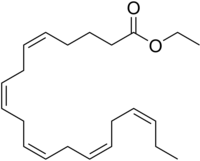
Back حمض إيثيل إيكوسابنتانويك Arabic اسید اتیل ایکوزاپنتانوئیک AZB اسید اتیل ایکوزاپنتانوئیک FA Icosapent éthyl French ଇଥାଇଲ ଇକୋସାପେଣ୍ଟେନୋଇକ ଏସିଡ OR Etil eikosapentaenoinska kiselina SH Etil eikosapentaenoinska kiselina Serbian
The examples and perspective in this article deal primarily with the United States and do not represent a worldwide view of the subject. (June 2021) |
 | |
| Clinical data | |
|---|---|
| Trade names | Vascepa, Vazkepa |
| Other names | Eicosapentaenoic acid ethyl ester; Ethyl eicosapentaenoate; Eicosapent; EPA ethyl ester; E-EPA, Icosapent ethyl (USAN US) |
| AHFS/Drugs.com | Monograph |
| MedlinePlus | a613024 |
| License data | |
| Pregnancy category |
|
| Routes of administration | By mouth |
| Drug class | Antilipemic Agents |
| ATC code |
|
| Legal status | |
| Legal status | |
| Identifiers | |
| |
| CAS Number | |
| PubChem CID | |
| IUPHAR/BPS | |
| DrugBank | |
| ChemSpider | |
| UNII | |
| KEGG | |
| ChEBI | |
| ChEMBL | |
| CompTox Dashboard (EPA) | |
| Chemical and physical data | |
| Formula | C22H34O2 |
| Molar mass | 330.512 g·mol−1 |
| 3D model (JSmol) | |
| |
| |
| | |
Ethyl eicosapentaenoic acid (E-EPA, icosapent ethyl), sold under the brand name Vascepa among others, is a medication used to treat dyslipidemia[4] and hypertriglyceridemia.[3] It is used in combination with changes in diet in adults with hypertriglyceridemia ≥ 150 mg/dL. Further, it is often required to be used with a statin (maximally-tolerated dose).[6]
The most common side effects are musculoskeletal pain, peripheral edema (swelling of legs and hands), atrial fibrillation, and arthralgia (joint pain).[6] Other common side effects include bleeding, constipation, gout, and rash.[4]
It is made from the omega−3 fatty acid eicosapentaenoic acid (EPA).[6] The US Food and Drug Administration (FDA) granted the approval of icosapent ethyl in 2012 to Amarin Corporation, and it became the second fish oil-based medication after omega-3-acid ethyl esters (brand named Lovaza, itself approved in 2004).[7] On 13 December 2019, the FDA also approved Vascepa as the first drug specifically "to reduce cardiovascular risk among people with elevated triglyceride levels".[6] It is available as a generic medication.[8] In 2022, it was the 229th most commonly prescribed medication in the United States, with more than 1 million prescriptions.[9][10]
- ^ a b "Vazkepa". Therapeutic Goods Administration (TGA). 22 November 2022. Archived from the original on 5 February 2023. Retrieved 29 April 2023.
- ^ "Summary Basis of Decision (SBD) for Vascepa". Health Canada. 23 October 2014. Archived from the original on 31 May 2022. Retrieved 29 May 2022.
- ^ a b Cite error: The named reference
Vascepa FDA labelwas invoked but never defined (see the help page). - ^ a b c "Vazkepa EPAR". European Medicines Agency (EMA). 25 January 2021. Archived from the original on 9 July 2021. Retrieved 7 July 2021.
- ^ "Vazkepa Product information". Union Register of medicinal products. Archived from the original on 5 March 2023. Retrieved 3 March 2023.
- ^ a b c d "FDA approves use of drug to reduce risk of cardiovascular events in certain adult patient groups". U.S. Food and Drug Administration (FDA) (Press release). 13 December 2019. Archived from the original on 22 December 2019. Retrieved 21 December 2019.
 This article incorporates text from this source, which is in the public domain.
This article incorporates text from this source, which is in the public domain.
- ^ Cite error: The named reference
2015CompareRevwas invoked but never defined (see the help page). - ^ "Icosapent ethyl: FDA-Approved Drugs". U.S. Food and Drug Administration (FDA). Archived from the original on 19 October 2020. Retrieved 15 August 2020.
- ^ "The Top 300 of 2022". ClinCalc. Archived from the original on 30 August 2024. Retrieved 30 August 2024.
- ^ "Icosapent Ethyl Drug Usage Statistics, United States, 2013 - 2022". ClinCalc. Retrieved 30 August 2024.